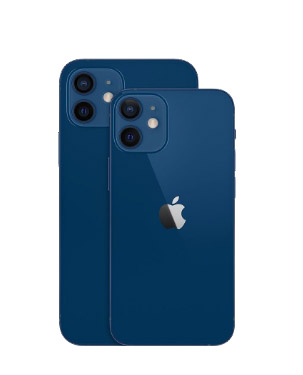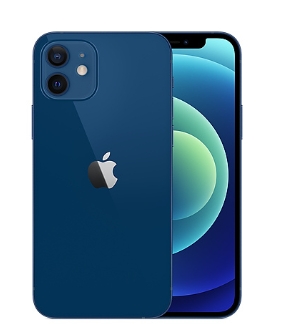Last Updated on January 1, 2021 by Rick Darlinton
Apple is notorious for unveiling new iPhones annually, and 2020 was no exception. The latest additions to the Apple family spot new features that are expected to sway those still sitting on the fence.
2020 welcomed the release of four new iPhones:
- iPhone 12 Mini
- iPhone 12
- iPhone 12 Pro
- iPhone 12 Pro Max
Here’s a breakdown of iPhone 12 comparison, so you’re fully aware of what you’re getting.
iPhone 12 Mini
Looking for the smallest iPhone 12? Then you’ll like the iPhone 12 Mini. The smartphone’s 5.4 inches diagonal size makes it the perfect fit for small hands and tight pockets.
With a resolution of 2340 x 1080 pixels, it’s no different from the iPhone 12 in the brightness department – a significant feat considering the size difference.

Despite its size constraints, the 12 Mini is still a delightful help when capturing the moments. Those camera bumps aren’t there just for aesthetics.
On the glass rear of the iPhone 12 Mini are the optics: 12MP main camera and 12MP ultrawide camera. The drop-down in size of the iPhone 12 Mini doesn’t affect its camera setup. Visuals are crisp, clear, and vivid. While the main camera dazzles, the front-facing one appears to be lagging – it doesn’t hold a candle to the rear cameras.
The iPhone 12 can handle all sorts of operations – surfing the web, gaming, video streaming, and others – through its A14 processor, with a speed of 3GHz.
Keeping multiple apps open on the iPhone 12 Mini is made possible by its 4GB RAM status. Available storage capacity differs with the variant, ranging from 64GB to 256GB, but the price goes up as well.
Another area where the iPhone 12 mini appears to be shortchanged is its battery power. While the battery specifics of every iPhone is shrouded in mystery, the status of the gadget tells the whole story.
The iPhone 12 Mini goes off sooner than its other siblings in the series, lasting just 10 hours on a single charge. It’s certainly a tough choice for anyone looking to use the device for long spells before charging.
iPhone 12
The iPhone 12 is a bigger version of the 12 Mini – its 6.1 inches screen says it all. Like the iPhone 12 Mini, this one has a glass rear and a ceramic-glass blend in front. The combination of ceramic and glass makes the iPhone 12 screen more rugged.

Compared to previous installments, the iPhone 12 is considerably flat sides – you can bid farewell to the curved edges of the iPhone 11 and its older siblings. It’s easy to tell the iPhone 12 from the pro versions through the former’s aluminum rail.
Unlike its older sibling, the iPhone 11, the iPhone 12 comes with an OLED screen. It’s a costly upgrade on the iPhone 11’s LCD screen, but the OLED helps maximize every inch of the iPhone 12’s smaller size.
The higher resolution of the iPhone 12’s display – 1170 x 2532 – makes it a significant step up from the iPhone 11’s 1792 x 898 display resolution.
The only drawback of the iPhone 12’s screen is its uninspiring refresh rate – it’s abysmal when compared to the flagship Android devices like the Samsung Galaxy S20 gadget. You won’t be unlocking the iPhone 12 by touch, that’s for sure.
The camera architecture of the iPhone 12 is similar to the 12 Mini – two 12MP rear shooters and a 12MP selfie camera. The rear cameras possess an ƒ/1.6 aperture, an influential attribute in the capabilities of both cameras.
At the center of the iPhone 12’s processing prowess is the A14 Bionic, Apple’s latest processor – and it’s an upgrade on the outstanding A13 found on the iPhone 11 Pro.
Thanks to the A14 Bionic, the iPhone 12 handles multiple tasks in record time. Apple claims its latest device uses a GPU that’s about 50% quicker than the iPhone 11’s A13.
As you know, the battery details of Apple devices aren’t public knowledge, and it’s the same story with the iPhone 12.
You can expect to use the iPhone 12 for as much as 10 hours on a single charge. Of course, this will depend on your use of the device. The iPhone 12’s battery capacity is better than the 12 Mini, but it’s behind that of the iPhone 11.
iPhone 12 Pro
There’s very little difference between the iPhone 12 and the 12 Pro. Both are quite flat and it shows how thin these devices are. Yet, the iPhone 12 Pro isn’t flimsy. It’s near massive compared to the iPhone 11 Pro.

One area where the iPhone 12 Pro takes a different path from the iPhone 12 is its stainless steel rail. The glossy alloy gives the iPhone 12 Pro an enticing appearance. But the attractive frame has one flaw: it picks up fingerprints too easily. Fortunately, using a phone case will circumvent this challenge.
Like the iPhone 12, the Pro version has the glass-ceramic blend, ‘ceramic shield’ protecting its OLED display. The mix of ceramic and glass does wonders for the durability of the screen.
Talking about the OLED display, it’s precisely the same as that seen on the iPhone 12. Even the refresh rate – a miserly 60Hz – is unchanged in the 12 Pro.
As far as the cameras are concerned, the iPhone 12 Pro has an additional rear 12MP lens. That makes it four cameras on one device. But the main camera takes the cake – the images are sharper and crispier. There’s also a LiDAR sensor on the iPhone 12 Pro, so you can expect better portrait shots.
The other thing unique about the iPhone 12 Pro is its RAM and storage capacity. While the standard iPhone 12 has 4GB RAM and 64GB storage space, the Pro Version is equipped with 6GB RAM and 128GB storage capacity.
iPhone 12 Pro Max
It’s the largest iPhone yet. The iPhone 12 Pro Max has a massive 6.7-inch screen. Add its 8.0-ounce weight, and you have a gadget not meant for weak hands.
Similar to the iPhone 12 Pro, the Max is equipped with an OLED display but the resolution is a higher 2778 x 1284. This should improve the overall viewing experience of the iPhone 12 Pro Max.
The camera architecture of the iPhone 12 Pro Max isn’t so different from its smaller sibling, the iPhone 12 Pro, but it has a more sensitive sensor and better zoom. This should make for a general improvement in picture quality.
The battery is the only other area where the iPhone 12 Pro Max outwits the Pro. It has a bigger 3687mAh battery, so you can expect to use the phone for much longer before having to recharge.
